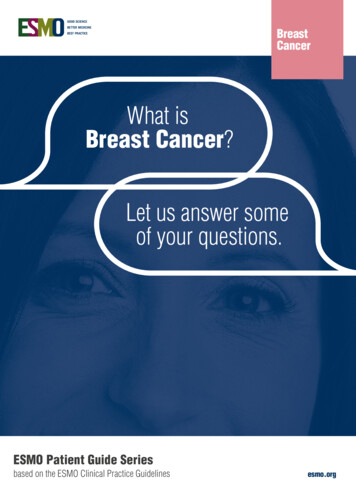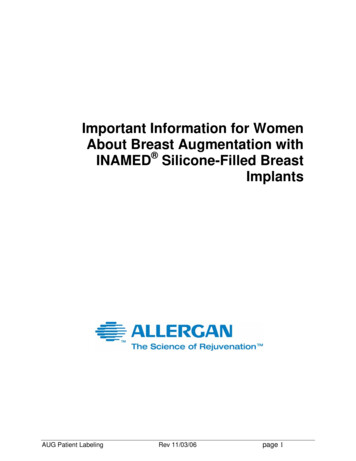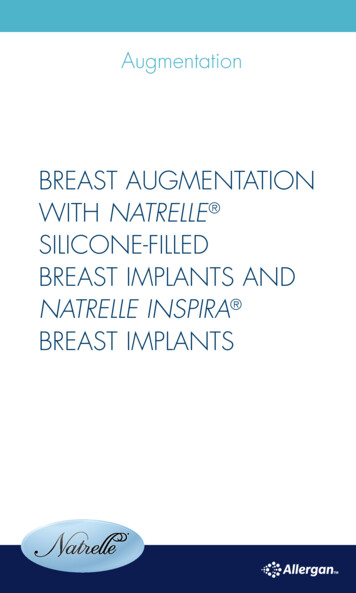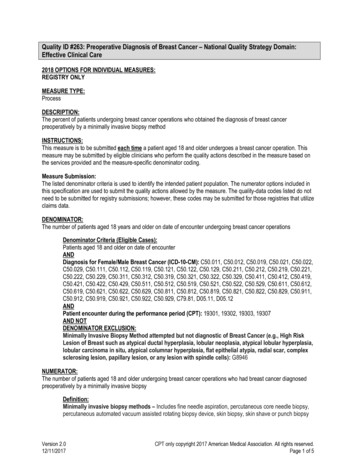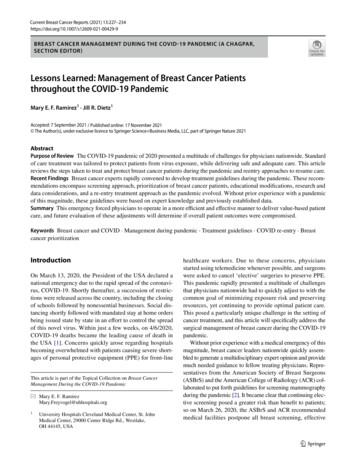
Transcription
Current Breast Cancer Reports (2021) 29-9BREAST CANCER MANAGEMENT DURING THE COVID-19 PANDEMIC (A CHAGPAR,SECTION EDITOR)Lessons Learned: Management of Breast Cancer Patientsthroughout the COVID‑19 PandemicMary E. F. Ramirez1 · Jill R. Dietz1Accepted: 7 September 2021 / Published online: 17 November 2021 The Author(s), under exclusive licence to Springer Science Business Media, LLC, part of Springer Nature 2021AbstractPurpose of Review The COVID-19 pandemic of 2020 presented a multitude of challenges for physicians nationwide. Standardof care treatment was tailored to protect patients from virus exposure, while delivering safe and adequate care. This articlereviews the steps taken to treat and protect breast cancer patients during the pandemic and reentry approaches to resume care.Recent Findings Breast cancer experts rapidly convened to develop treatment guidelines during the pandemic. These recommendations encompass screening approach, prioritization of breast cancer patients, educational modifications, research anddata considerations, and a re-entry treatment approach as the pandemic evolved. Without prior experience with a pandemicof this magnitude, these guidelines were based on expert knowledge and previously established data.Summary This emergency forced physicians to operate in a more efficient and effective manner to deliver value-based patientcare, and future evaluation of these adjustments will determine if overall patient outcomes were compromised.Keywords Breast cancer and COVID · Management during pandemic · Treatment guidelines · COVID re-entry · Breastcancer prioritizationIntroductionOn March 13, 2020, the President of the USA declared anational emergency due to the rapid spread of the coronavirus, COVID-19. Shortly thereafter, a succession of restrictions were released across the country, including the closingof schools followed by nonessential businesses. Social distancing shortly followed with mandated stay at home ordersbeing issued state by state in an effort to control the spreadof this novel virus. Within just a few weeks, on 4/6/2020,COVID-19 deaths became the leading cause of death inthe USA [1]. Concerns quickly arose regarding hospitalsbecoming overwhelmed with patients causing severe shortages of personal protective equipment (PPE) for front-lineThis article is part of the Topical Collection on Breast CancerManagement During the COVID-19 Pandemic* Mary E. F. RamirezMary.Freyvogel@uhhospitals.org1University Hospitals Cleveland Medical Center, St. JohnMedical Center, 29000 Center Ridge Rd., Westlake,OH 44145, USAhealthcare workers. Due to these concerns, physiciansstarted using telemedicine whenever possible, and surgeonswere asked to cancel ‘elective’ surgeries to preserve PPE.This pandemic rapidly presented a multitude of challengesthat physicians nationwide had to quickly adjust to with thecommon goal of minimizing exposure risk and preservingresources, yet continuing to provide optimal patient care.This posed a particularly unique challenge in the setting ofcancer treatment, and this article will specifically address thesurgical management of breast cancer during the COVID-19pandemic.Without prior experience with a medical emergency of thismagnitude, breast cancer leaders nationwide quickly assembled to generate a multidisciplinary expert opinion and providemuch needed guidance to fellow treating physicians. Representatives from the American Society of Breast Surgeons(ASBrS) and the American College of Radiology (ACR) collaborated to put forth guidelines for screening mammographyduring the pandemic [2]. It became clear that continuing elective screening posed a greater risk than benefit to patients;so on March 26, 2020, the ASBrS and ACR recommendedmedical facilities postpone all breast screening, effective13Vol.:(0123456789)
228immediately. This recommendation was to be re-evaluated ona weekly basis based upon the geographic impact of the virus.The ASBrS forum, a large community chat room for members, quickly became overwhelmed with requests for assistance in treating breast cancer patients during the surgeryshutdown. The breast cancer consortium was quickly created,comprising members from the ASBrS, National AccreditationProgram for Breast Centers (NAPBC), National Comprehensive Care Network (NCCN), Commission on Cancer (CoC),and ACR. This expert group assembled to develop treatmentrecommendations based on a prioritization of breast cancerpatients [3 ]. Within a week, they wrote and edited theserecommendations, which were then posted by all participatingorganizations, including the American College of Surgeons(ACS), to make them readily available to breast cancer physicians everywhere [4]. Shortly thereafter, the priority recommendations were published in a peer-reviewed journal andaccessed globally [3 ]. Similar recommendations were alsocreated by other university breast centers, such as Dana-FarberCancer Institute and University of Pittsburgh Magee Women’sHospital [5, 6]. These recommendations were not meant tosupersede individual physician judgment or institutional policies/guidelines, rather, give treating physicians a guide to follow during such an uncertain time.The impact of coronavirus on the cancer patient can besignificant due to the need for multiple visits to a healthcarefacility as well as the immunocompromised state caused bythe disease itself and proposed treatments. These patientsmay be more susceptible to infection, and recent small casestudies have shown worse outcomes from coronavirus incancer patients than those without cancer [7–9]. Patientshaving received chemotherapy or surgery within 30 days ofcontracting COVID-19 carried a higher risk of severe eventscompared to those who had not [8]. Cancer patients are alsooften older with more comorbidities increasing their risk ofcomplications [9]. Careful consideration must be made in thecancer population to both protect them from exposure andprovide effective and safe treatment of their disease. Safetymeasures should include implementation of strict infectioncontrol and treatment in the outpatient setting rather thanhospitalization, whenever safe and feasible. The followingis a review of the recommended prioritization in the breastcancer population, provided by ‘The COVID-19 pandemicbreast cancer consortium’ during this unprecedented time[3 ].Prioritization RecommendationsBreast cancer patients were divided into ‘Priorities’ basedon the severity of their disease as well as the potential risksand benefits of the required treatment. These priorities werecreated across all disciplines of breast cancer management.13Current Breast Cancer Reports (2021) 13:227–234‘Priority A’ included patients with an immediately lifethreatening or clinically unstable conditions. Thesepatients were assigned top priority for urgent treatment,regardless of resource availability.‘Priority B’ included patients who did not have a lifethreatening condition, but whose treatment should notbe indefinitely delayed. This priority captures a largemajority of breast cancer patients and a short delay intreatment (6–12 weeks) was not felt to impact overall outcome. Subclassifications were created within this groupto assist with further prioritization, should further delaybecome necessary.‘Priority C’ included patients whose treatment couldsafely be delayed indefinitely with no negative impact onoverall outcome.These priority groups were applied to each facet of themultidisciplinary treatment of breast cancer, including initialwork-up in the office, imaging studies, surgical oncology,medical oncology, and radiation oncology. We will addressthe workup and surgical management here.Outpatient WorkupThe expert consortium recommended that the majority of outpatient encounters be conducted via telemedicine in effortsto reduce the risk of viral transmission between patients andhealthcare workers. At this virtual visit, the physician can further evaluate the potential need for an in-person encounter. Priority A patients would include anyone in need of an in-personvisit, for example, unstable postoperative patients. Priority Bpatients should be evaluated in person by one of the multidisciplinary team members initially. This would include newly diagnosed breast cancer patients, established patients with a newbreast complaint requiring further workup, and routine postoperative patients. Priority C patients can be seen virtually ordelayed until after the pandemic. This category would includeroutine follow-up, survivorship visits, or high-risk screening.Breast ImagingPatients may be brought in for breast-specific imaging if designated Priority A. These patients may have urgent issues such asbreast abscess or serious postoperative complication. PriorityB patients would include diagnostic imaging for an abnormalscreening study, biopsies for a BIRADS-4 or 5 lesion, breastMRI for further evaluation of newly diagnosed breast canceror to assess response to chemotherapy. Lower suspicion lesionssuch as BIRADS-4a could be postponed, and BIRADS-3patients due for follow-up imaging could be delayed until afterthe pandemic. All screening studies could be placed in PriorityC and postponed until after the pandemic.
Current Breast Cancer Reports (2021) 13:227–234Surgical OncologyThe COVID-19 breast cancer consortium formulated a listof patient scenarios by priority in regard to surgical management of their disease. The overall objective in delaying surgeries is to preserve the necessary PPE required to managethe expected influx of COVID-19 patients. In order to avoidadversely impacting breast cancer outcomes, multidisciplinary input is recommended in the decision-making processof which patients’ treatments can be safely delayed.Priority A patients include those requiring immediate surgicalattention such as abscess drainage or expanding postoperative hematoma. Priority B patients include high-risk cancer patients with moreaggressive tumor biology, such as triple negative and HER2 . Patientscompleting neoadjuvant chemotherapy should also be kept on a strictschedule for surgery as they would be at risk for disease progression ifdelayed. Patients with hormone-sensitive cancers can be consideredfor neoadjuvant endocrine therapy to temporize their disease until surgery is more feasible. Finally, Priority C patients would include earlystage disease such as ductal carcinoma in situ (DCIS) and clinicallynode-negative, hormone-positive invasive disease. These cases can bedelayed, and/or hormonal therapy can be initiated for temporization.High-risk lesions, benign lesions, and prophylactic surgeries are recommended to be delayed until after the pandemic.Similar recommendations arose from highly respectedinstitutions, such as Dana-Farber Cancer Institute and MageeWomen’s Hospital (UPMC) [5, 6]. There was a general similarity among the consensus recommendations. Dana Farberrecommended clinical monitoring every 8 weeks to evaluatefor disease progression [5]. UPMC recommendations also mirrored the consortiums with the common goals of preservingPPE, limiting in-person visits and delaying non-urgent surgicalprocedures. The risk/benefit ratio of delaying surgery should beconsidered for each patient individually. If the risk of postponing breast cancer surgery poses little to no harm, this should bea consideration and discussed with the patient [6].With the assistance and guidance from these breast cancerexperts, physicians were quickly tailoring their practice to accommodate both the pandemic risks and necessity for patient care.Several areas of overlap are seen among these recommendations,and multidisciplinary input is ideal and recommended for allpatients. The goal of these recommendations is to help guide thedecision-making process for breast cancer patients by weighingthe risk that cancer treatment may increase the susceptibility ofCOVID-19 infection vs the risk of adverse oncologic outcomesfrom delaying their treatment until the pandemic resolved.Educational ModificationsIn addition to surgeries and in-person visits being tailored,national educational conferences in 2020 were widely canceleddue to travel restrictions and the need for social distancing.229These conferences are largely relied upon by physiciansnationwide for ongoing education, and there was a call toaction to continue to provide relevant educational opportunities. One such conference by the ASBrS was quickly adjustedto accommodate physicians from a distance. The leadershipcommittee transformed this largely attended in-person meeting to a virtual one. The society was already offering weeklyvirtual breast fellow education, which was then expanded tothe entire breast community. Multidisciplinary COVID-19tumor boards were broadcasted and many of the consortiummembers participated. The newly created virtual 2020 meetingseries delivered topics to assist with the treatment of breastcancer patients during the pandemic. Some relevant lecturetopics included ‘Endocrine therapy’, ‘Pain management andEnhanced Recovery After Surgery (ERAS) procedures forsame day mastectomy’ and ‘Coding tips on billing for telemedicine’, to name a few. In addition to the ASBrS, severalsocieties strengthened their year-round virtual educationalplatform in order to contribute to the mission of continuing toeducate treating physicians. The common goals of these virtualmeetings are to provide treatment recommendations, discusschanges to coding and reimbursement, offer data collectionopportunities, and highlight legislative and regulatory updates.Unique ‘hands-on’ virtual teaching models are also beingevaluated to provide small group learning and certificationfor oncoplastic, ultrasound, and stereotactic techniques. TheASBrS created a COVID-19 Resource Center that includespublished recommendations regarding surgery, treatment, andscreening during the pandemic. Quick links are provided tothe top published papers as well as information for billing andcoding in the newfound setting of telehealth visits. (https:// www. breas tsurg eons. org).Another focus has been providing a platform for membersand industry partners to interact and stay updated on the latesttechnology. Industry partners have sponsored virtual webinars,and exhibit halls have been well attended, both of which haveserved to enrich our educational platform. The Corporate Relations Committee and Board has shifted in-person meetingswith the Industry Relations Council (IRC) to virtual discussions with the shared goal of finding value in the incorporationof technology, genomic testing, and improved drugs for thetreatment of breast cancer.Research and Data CollectionMany breast cancer trials were closed to accrual early onin the pandemic with resource teams refocused on registries and studies related to COVID-19. Even though manystudies have reopened, patients remain reluctant to makeadditional visits or contacts, and accrual numbers havenot returned to normal. Dozens of manuscripts have beenpublished in the last six months outlining care, describing13
230changes in practice and looking at early outcomes ofbreast cancer patients during the COVID-19 pandemic.The NAPBC, ASBrS, and many other groups realizedthe importance of collecting data regarding the changesin practice, mandated by the pandemic. The NAPBC andASBrS sent out a survey to members asking about practice changes and impacts of the pandemic on physicians.The ASBrS created a COVID-19-specific patient registrygiving member physicians an opportunity to input patientdata via a HIPAA-compliant program and see how others are treating patients during the pandemic. This wasadded to the existing ‘Mastery’ registry and to date, 234physicians have entered data with regard to the impactof COVID-19 on 2224 patients. This will provide muchneeded information for ongoing research and interpretation of how patients fared during the pandemic, given theneed to tailor standard of care treatment. (https:// www. breas tsurg eons. org/ resou rces/ covid 19 regis try).With the same future goals in sight, additional organizations created similar registries of their own. The American Society of Clinical Oncology (ASCO) launched the‘ASCO Survey on COVID-19 in Oncology Registry’ onApril 10, 2020 [10]. This registry is meant to captureinformation about symptoms and severity of the virus incancer patients as well as how the virus has impacted theircare and outcomes. It aims to collect baseline and followup data during and after the pandemic in hopes of elucidating longer-term effects of COVID-19 and its impact oncancer care [10]. Access to this registry can be found athttps:// www. asco. org/ asco- coron avirus- infor mation/ coron avirus- regis try. In addition, the ACS developed a registryto collect data on COVID-19 patients who did and did notundergo surgery. This registry will capture a multitudeof patients, with cancer patients comprising a subset ofthem [11]. All hospitals are encouraged to participate andadditional information can be found at https:// www. facs. org/ quali ty- progr ams/ covid 19- regis try.Re‑entry ApproachAs the pandemic seemed to improve with social distancing and stay at home orders, the idea of reopening wasconsidered. The reopening strategy would differ across thecountry based on geographic conditions related to PPE,COVID-19 case load, and the ability to safely accommodate high-risk patients. Similar to the prioritizationrecommendations, the COVID-19 pandemic breast cancer consortium again convened to publish further recommendations regarding how to safely resume care of breastcancer patients [12 ]. In addition to the previously published consortium, members from ASCO and the Society13Current Breast Cancer Reports (2021) 13:227–234of Surgical Oncology (SSO) joined to assist with the reentry guidelines.Breast cancer is the most common cancer amongwomen, and restoration of care is vital as the pandemicsubsides. This group of nationwide breast cancer expertsdeveloped multiple vignettes to help demonstrate the risksand benefits of reinstituting treatment. These recommendations are aimed at safely resuming multidisciplinary breastcancer care to patients whose treatment had been placedon hold or modified during the pandemic. Five primaryclinical questions were identified and addressed in thismanuscript and will be summarized here. The full articlecan be found at https:// www. breas tsurg eons. org/ docs/ covid 19/ reent r y. pdf? v1.1. How do we care for our asymptomatic but high-riskpatients presenting for office visits in the post-COVIDera?Breast cancer patients will begin to return tooutpatient clinics and offices; however, it will beimportant to maintain social distancing practicesto minimize close contact in waiting rooms andexam rooms. Telehealth visits are still encouragedwhen clinically appropriate, and physicians willneed to determine who would require an in-person visit for adequate evaluation. Local infectioncontrol policies will need to be followed based ongeographic region. This may include screening forsymptoms or potential exposure prior to and uponarrival to the facilities. Access to routine imagingwill likely be dependent on regional availabilityand patients should be prioritized based on screening vs diagnostic necessity. Screening vs diagnostic necessity should follow standard guidelines,and high-risk individuals requiring mammographyand MRI should be prioritized when schedulingresumes. Patients requiring image-guided procedures should be screened and tested for COVID19 accordingly. Patients who test positive forCOVID-19 should have their procedure delayedto protect staff from exposure.2. How do we handle the backlog of patients whose surgical treatment was delayed due to the pandemic?As operating rooms gradually reopen, a multitude of specialties will be contending for ORtime and availability for their patients. Prioritization models should be used to help assess theurgency of cases to be rescheduled. In regard tobreast cancer patients, the previously definedprioritization of patients should be used to assistwith this rescheduling process. Other considera-
Current Breast Cancer Reports (2021) 13:227–234tions should also include overall patient health,risk of COVID-19 exposure, and local hospitalresource availability [12 , 13].The consortium recommendations assign patients receiving neoadjuvant chemotherapy as high-prioritypatients. Conversely, those with early-stage hormone-sensitive cancers, atypia, or benign lesionswill fall lower on the list of priority during thereopening phase. Massachusetts General Hospital (MGH) also published re-entry guidelinesfor breast cancer patients who were subject totreatment delay [14 ]. Many patients managedwith neoadjuvant endocrine therapy or chemotherapy will become high priority for surgery astheir initial treatment comes to an end. Furtherdelay in these patients could compromise overall outcome. To address the need for a fair andtransparent system of reprioritization of surgical patients, MGH created a scoring system forsurgical assignment. Aspects considered wererelated to risk of delaying surgery and wereassigned a score by a multidisciplinary breastteam. A multitude of factors were recorded foreach patient including biologic details of the cancer diagnosis, time from diagnosis, completiondate of neoadjuvant therapy and evidence of progression on follow-up. Records were maintainedin REDCap and Microsoft Excel formats. Higherscores were deemed to carry a greater risk fromdelaying surgery. Scores were assigned usingpublished data and multidisciplinary expertise.Overall scores were divided into ‘very urgent’,(score 30), ‘limited delay acceptable’ (score10-29), and ‘lowest priority’ (score 10). Veryurgent cases have a narrow window for surgerybetween 2 and 4 weeks. Limited delay patientsmay become urgent, and surgery would ideallyoccur between 2 and 4 months. Lowest prioritypatients can safely wait until after the pandemicwithout anticipated harm. This tool offers arisk-stratified list of breast conditions where surgical delay was mandated during the COVID-19pandemic. The scoring system provides a priority ranking, consistent with the consortium’srecommendations, to guide practicing physiciansin the care of their patients. Use of tools such asthis can also provide necessary data for potential future situations where surgery may need tobe delayed [14 ]. This tool can be accessed athttps:// www. massg eneral. org/ surgi cal- oncol ogy/ about/ news- and- events/ re- entry- tool- for- breast- surge ons/.2313. As our operating rooms reopen, how should patientswho were placed on endocrine therapy prior to definitive surgery be managed?Typically, patients with early-stage, hormonesensitive breast cancers receive surgery andradiation, followed by endocrine therapy. Dueto implications from the pandemic, many havebeen placed on endocrine therapy prior to othertherapies in order to delay surgery but not effectoverall outcome. Patient factors should be takeninto account when reprioritizing these patients forsurgery. Factors such as age, comorbidities, riskof COVID-19 infection, response to systemic therapy, and geographic resource availability are a fewexamples. If the patient does not show any signsof progression on endocrine therapy, either clinically or radiographically, this may be continuedwith plans for further repeat imaging prior to surgery. In patients receiving neoadjuvant endocrinetherapy who are rescheduled for breast-conservingsurgery, it is felt reasonable by the consortium toapply ACOSOG Z0011 criteria and perform sentinel lymph node biopsy alone. This is controversial and individual physician and patient comfortlevel is important to consider. For patients whowere not initially eligible for breast conservation,6 months of preoperative endocrine therapy couldbe considered to increase the potential of downsizing the tumor and converting to breast conservation. As long as the disease appears stable andcontinues to respond, endocrine therapy may becontinued to maximize treatment effect. Repeatinghormone receptors after 6–12 months of standardof care, neoadjuvant endocrine therapy is recommended. With these recommendations in place,a study published in the Journal of the AmericanCollege of Surgeons established that a longertime from diagnosis to surgical treatment in thispatient population did not lower overall survival[15]. To further elucidate the impact of surgicaldelay during the pandemic, this study evaluated378,839 patients from the National Cancer Database (NCD) with DCIS or early-stage ER breastcancer treated between 2010 and 2016. Time tooperation was recorded along with factors associated with pathologic upstaging. Upon final analysis, this study concluded that patients treatedwith neoadjuvant endocrine therapy exhibited nosurvival difference in regard to time to operation.Among patients receiving primary surgical treatment, surgical delays of more than 60 days wereassociated with pathologic upstaging in patients13
232Current Breast Cancer Reports (2021) 13:227–234with DCIS but not invasive disease [15]. Althoughthe patient population is not equivalent to thosedelayed during the pandemic, these results canprovide some reassurance to treating physiciansin regard to surgical delay in this patient population.4. As we emerge from the pandemic, how do we managepatients who have already begun neoadjuvant chemotherapy?When evaluating surgical options for a patientreceiving neoadjuvant chemotherapy, consideration of current extent of the pandemic and available local resources must first be gauged. Factorsintrinsic to the breast cancer diagnosis are thenevaluated including subtype, treatment response,patient comorbidities, and complications duringtreatment. The consortium agreed that patientsshowing signs of progression on chemotherapy, orthose with no effective alternative therapy optionsare considered high priority for surgery and shouldnot have further delay [3 ]. The overall approachto patients receiving neoadjuvant chemotherapyshould concentrate on minimizing exposure inclinic and minimizing immunosuppression fromchemotherapy. Upon completion of chemotherapy,these patients are high priority for surgery andshould be scheduled. If barriers exist to schedulingsurgery and the patient has the option of endocrinetherapy, this can be initiated to avoid further treatment delay, however, this is not standard of care.In this extenuating circumstance, careful clinicalfollow-up is recommended to assess for potentialprogression of disease.There is limited dataon outcomes of patients with cancer who contractCOVID-19. Available data exhibit higher rates ofcomplications and mortality compared to the noncancer population; however, this data was on smallsubsets of patients and largely focused on lung cancer patients, not breast cancer patients [7]. A studyfrom Columbia University showed encouragingresults among breast cancer patients specificallywho contracted COVID-19 [16]. It was a smallstudy of 27 breast cancer patients who were treatedfor coronavirus and also received breast cancertreatment within the previous 6 months. Ninety-sixpercent of patients were symptomatic from COVID19 and 26% (7) were hospitalized. All patients weredischarged home; however, following discharge, theonly male patient died [16]. Although these resultsare promising, the overall aim should still concentrate on reducing clinic visits and potential exposureduring treatment.135. How do we manage a patient who is not a candidate forbreast-conserving surgery but is ready for their operation?The extent of breast surgery required determinesthe need for postoperative care, and during thepandemic, limiting exposure to the inpatient setting is an important factor to consider. For patientsrequiring mastectomy, reconstruction can still beconsidered, but should be limited to the affectedbreast and should include placement of tissueexpander or implant. Autologous reconstruction isnot recommended and should not be offered untilconditions and resources allow. Consideration ofbilateral mastectomy may be given for patients athigh risk of developing contralateral breast cancer (such as young age, genetic predisposition,ER-negative disease), if local conditions allow.Decreasing length of hospital stay and complications after mastectomy, with or without reconstruction, must be carefully considered. EnhancedRecovery After Surgery (ERAS) is an approachthat can be useful in this population of patients toenable patients to recover more quickly and miniThe ASBrSmize inpatient exposure [17, 18].formed an expert committee with nominatedmembers from the ACS, SSO, American Societyof Plastic Surgeons (ASPS), and The AmericanSociety of Anesthesiologists (ASA). This committee developed treatment recommendationsfor decreased opioid use in postoperative breastsurgery patients. The manuscript also providesstrategies for same day discharge for mastectomypatients which is helpful to decrease potentialvirus exposure [18].ConclusionAs the pandemic continues to evolve, regional differences existregarding COVID-19 case load and hospital resource availability which will lead to variation in the ability of institutions toreopen patient services. Primary principles for re-entry shouldinclude providing standard of care treatment while weighingrisks and benefits of proposed treatments against virus exposure. Multidisciplinary input is paramount when making thesetreatment decisions and these recommendations should be discussed with the patient, soliciting their input while informingthem of risks of delayed treatment versus risk of exposure toCOVID-19. These extraordinary times have presented physicians and patients with unique challenges, and the medical community must continue to come together to confrontthem in the safest, most effective manner possible. The global
Current Breast Cancer Reports (2021)
tance in treating breast cancer patients during the surgery shutdown. The breast cancer consortium was quickly created, comprising members from the ASBrS, National Accreditation Program for Breast Centers (NAPBC), National Comprehen-sive Care Network (NCCN), Commission on Cancer (CoC), and ACR. This expert group assembled to develop treatment
